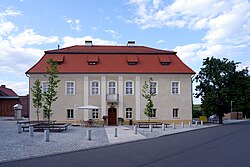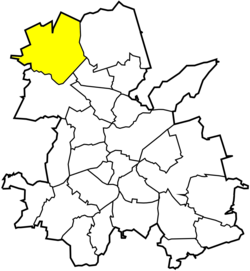Stodoły [stɔˈdɔwɨ] (lit. barns, German: Stodoll) is a district of Rybnik, Silesian Voivodeship, southern Poland. In the late 2013 it had about 600 inhabitants.[1]
Stodoły | |
|---|---|
 Manor house | |
 Location of Stodoły within Rybnik | |
| Coordinates: 50°09′26″N 18°28′59″E / 50.157206°N 18.483113°E | |
| Country | |
| Voivodeship | Silesian |
| County/City | Rybnik |
| Population (2013) | |
• Total | 600 |
| Time zone | UTC+1 (CET) |
| • Summer (DST) | UTC+2 (CEST) |
| Area code | (+48) 032 |
History
editThe village could have existed before 1258.
After World War I in the Upper Silesia plebiscite 260 out of 393 voters in Stodoły voted in favour of joining Poland, against 131 opting for staying in Germany.[2] Nevertheless it stayed a part of Germany, on the border with Poland. It was renamed as "Hochlinden" after campaign of cleansing "Non-German" place names in 1936.[citation needed] It was a place of a Nazi false flag operation (as part of Operation Himmler) on August 31, 1939.[3][4][5] After the war it became a part of Poland.
In years 1973-1977 it was a part of gmina Chwałęcice and was amalgamated with Rybnik on February 1, 1977.[6]
References
edit- ^ "Stodoły" (in Polish). rybnik.eu. Retrieved 2015-05-13.
- ^ "Results of the Upper Silesia plebiscite in Rybnik County" (in German). Archived from the original on 2016-03-04. Retrieved 2015-05-03.
- ^ "Prowokacja hitlerowska we wsi Stodoły to jeden z zapomnianych epizodów II wojny światowej" (in Polish). Dziennik Zachodni. 2007-08-31. Retrieved 2015-05-13.
- ^ Martin Allen, Himmler's Secret War: The Covert Peace Negotiations of Heinrich Himmler, Carroll & Graf Publishers, 2005, ISBN 0-7867-1708-4, Google Print, p.51
- ^ Christopher J. Ailsby, The Third Reich Day by Day, Zenith Imprint, 2001, ISBN 0-7603-1167-6, Google Print, p.112
- ^ Rozporządzenie Ministra Administracji, Gospodarki Terenowej i Ochrony Środowiska z dnia 25 stycznia 1977 r. w sprawie zmiany granic niektórych miast w województwie katowickim., Dz. U., 1977, vol. 3, No. 15